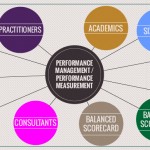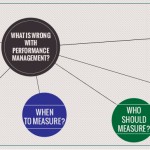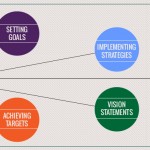Performance Management taxonomy – linking Performance Measurement and Management
smartKPIs.com Performance Architect update 14/2010
Taxonomy is a knowledge management tool used to provide structure to unstructured information. It is about categorizing individual elements into groups, categories or hierarchies based on common elements. The purpose of developing taxonomies is to enable findability and facilitate the identification of patterns. An example of taxonomy is the grouping of organisms in an ordered hierarchy that indicates natural relationships.
In business, taxonomies are used to group and categorize products and services in catalogs, to structure website contents and for structuring data in the document management system, among other uses. Taxonomies can also facilitate the understanding of concepts, by mapping the main topics relevant to in multiple, independent categories.
A taxonomy for Performance Management as a discipline is particularly useful, as the concept of Performance Management is generally perceived vastly differently in both practice and academic research. As a discipline, it is still in formation and there is no unified body of knowledge outlining its structure and boundaries. Below is an initial draft of the taxonomy for performance management. It is listed in a linear format, as it is still work in progress. A more complex map of the taxonomy can be structured once it matures:
Performance management
Levels of use
- Organizational(Strategic)
- Functional (Operational)
- Individual (Employees)
Functions
- Establishment of desired outcomes
- Measurement of outcome achievement
- Monitoring of how plans are implemented
- Facilitation of learning by performance results analysis
- Alignment of organizational systems to a central performance management system
- Communication of plans and progress towards meeting them to all staff
- Communication of key performance data to external stakeholders
- Motivation of staff towards goal achievement
Key processes
- Performance management system design – architecture
- Performance management system implementation – building
- Performance management system maintenance – use
Tools
- Performance management business systems
- Performance management software systems
- Performance management processes
- Performance management subject matter experts
Systems or frameworks
- Tableau de bord
- Performance Prism
- Balanced Scorecard
Subsystems
- Performance measurement
- Performance analysis and modeling
- Performance management review
Direction instruments
- Vision
- Mission
- Values
- Destination statement
- Critical success factors / value drivers / key results indicators
- Strategy map
Performance measurement instruments
- Goals / Objectives
- Measures
- Performance indicators / metrics
- Key Performance Indicators
- smartKPIs
- Scorecards
- Dashboards
Performance management review instruments
- Performance reports
- Performance evaluations
- Initiatives
Listing and grouping such elements is a good first step. Exploring the relationships between them and linking them in a map structure will provide a much richer picture.
Stay smart! Enjoy smartKPIs.com!
Aurel Brudan
Performance Architect, www.smartKPIs.com

Tags: Aurel Brudan, Performance Architect Update, Taxonomy, Theory





